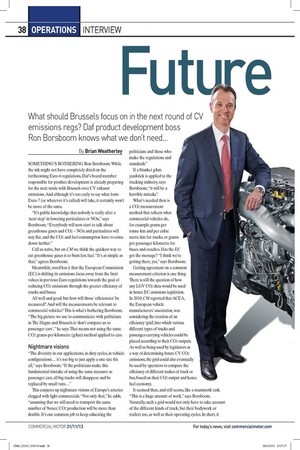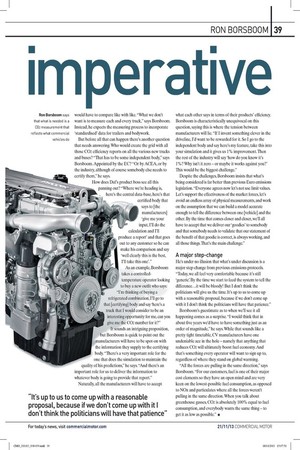Future
Page 28

Page 29

If you've noticed an error in this article please click here to report it so we can fix it.
Imperative
What should Brussels focus on in the next round of CV
emissions regs? Daf product development boss Ron Borsboom knows what we don't need... By Brian Weathertey
SOMETHING'S BOTHERING Ron Borsboom. While the ink might not have completely dried on the forthcoming Euro-6 regulations, Daf's board member responsible for product development is already preparing for the next tussle with Brussels over CV exhaust emissions. And although it's too early to say what form Euro-7 (or whatever it's called) will take, it certainly won't be more of the same.
"It's public knowledge that nobody is really after a 'next-step' in lowering particulates or NOx," says Borsboom. "Everybody will now start to talk about greenhouse gases and CO2 — NOx and particulates will stay flat, and the CO2 and fuel consumption have to come down further."
Call us naïve, but on CM we think the quickest way to cut greenhouse gases is to burn less fuel. "It's as simple as that," agrees Borsboom.
Meanwhile, word has it that the European Commission (EC) is shifting its emissions focus away from the limit values in previous Euro regulations towards the goal of reducing CO2 emissions through the greater efficiency of trucks and buses.
All well and good, but how will those 'efficiencies' be measured? And will the measurements be relevant to commercial vehicles? This is what's bothering Borsboom. "The big picture we use to communicate with politicians in The Hague and Brussels is 'don't compare us to passenger cars'," he says. That means not using the same CO2 grams-per-kilometre (g/km) method applied to cars. Nightmare visions
"The diversity in our applications, in duty cycles, in vehicle configurations... it's too big to just apply a one size fits all," says Borsboom. "If the politicians make this fundamental mistake of using the same measure as passenger cars, all big trucks will disappear and be replaced by small vans..." This conjures up nightmare visions of Europe's arteries clogged with light commercials. "Not only that," he adds, "assuming that we still need to transport the same number of 'boxes', CO2 production will be more than double. It's our common job to keep educating the politicians and those who make the regulations and standards" If a blanket g/km yardstick is applied to the trucking industry, says Borsboom, "it will be a horrible mistake': What's needed then is a CO2 measurement method that reflects what commercial vehicles do, for example grams per tonne-km and per cubic metre-km for trucks, or grams per passenger kilometre for buses and coaches. Has the EC
got the message? "I think we're getting there, yes," says Borsboom. Getting agreement on a common measurement criterion is one thing. There is still the question of how any LGV CO2 data would be used in future EC emissions legislation. In 2010, CM reported that ACEA, the European vehicle manufacturers' association, was considering the creation of an efficiency 'grid', into which various different types of trucks and passenger-carrying vehicles could be placed according to their CO2 outputs. As well as being used by legislators as a way of determining future CV CO2
emissions, the grid could also eventually be used by operators to compare the efficiency of different makes of truck or bus, based on their CO2 output and hence fuel economy. It seemed then, and still seems, like a mammoth task. "This is a huge amount of work," says Borsboom. Naturally, such a grid would not only have to take account of the different kinds of truck, but their bodywork or trailers too, as well as their operating cycles. In short, it
would have to compare like with like. "What we don't want is to measure each and every truck," says Borsboom. Instead, he expects the measuring process to incorporate 'standardised' data for trailers and bodywork.
But before all that can happen there's another question that needs answering. Who would create the grid with all those CO2 efficiency reports on all the various new trucks and buses? "That has to be some independent body," says Borsboom. Appointed by the EC? "Or by ACEA, or by the industry, although of course somebody else needs to certify them," he says. How does Daf's product boss see all this panning out? "Where we're heading is, here's the central data-base, here's that certified body that says to [the manufacturers] 'give me your input, I'll do the calculation and I'll produce a report' and that goes out to any customer so he can
make his comparison and say 'well clearly this is the best, I'll take this one'. As an example, Borsboom takes a controlled ' temperature operator looking to buy a new outfit who says: "I'm thinking of buying a refrigerated combination, I'll go to that [certifying] body and say 'here's a truck that I would consider to be an
interesting opportunity for me, can you give me the CO2 number for it?" It sounds an intriguing proposition, Put Borsboom is quick to point out the manufacturers will have to be spot-on with the information they supply to the certifying ■ body. "There's a very important role for the one that does the simulation to maintain the quality of his predictions," he says. "And there's an important role for us to deliver the information to whatever body is going to provide that report." Naturally, all the manufacturers will have to accept
what each other says in terms of their products' efficiency. Borsboom is characteristically unequivocal on this question, saying this is where the tension between manufacturers will lie. "If I invent something clever in the driveline, I'd want to be rewarded for it. So I go to the independent body and say here's my feature, take this into your simulation and it gives us 1% improvement. Then the rest of the industry will say 'how do you know it's 1%? Why isn't it zero — or maybe it works against you?' This would be the biggest challenge."
Despite the challenges, Borsboom insists that what's being considered is far better than previous Euro emissions legislation. "Everyone agrees now let's not use limit values. Let's support the effectiveness of the market forces, let's avoid an endless array of physical measurements, and work on the assumption that we can build a model accurate enough to tell the difference between one [vehicle] and the other. By the time that comes closer and closer, we'll all have to accept that we deliver our 'goodies' to somebody and that somebody needs to validate that our statement of the benefit of that goodie is correct, is always working, and all those things. That's the main challenge." A major step-change
He's under no illusion that what's under discussion is a major step-change from previous emissions protocols. "Today, we all feel very comfortable because it's still 'generic: By the time we start to feed the system to tell the difference.. .it will be bloody! But I don't think the politicians will give us the time. It's up to us to come up with a reasonable proposal, because if we don't come up with it I don't think the politicians will have that patience."
Borsboom's guestimate as to when we'll see it all happening comes as a surprise. "I would think that in about five years we'd have to have something just as an order of magnitude," he says. While that sounds like a pretty tight timetable, CV manufacturers have one undeniable ace in the hole — namely that anything that reduces CO2 will ultimately boost fuel economy. And that's something every operator will want to sign up to, regardless of where they stand on global warming. "All the forces are pulling in the same direction," says Borsboom. "For our customers, fuel is one of their major cost elements so they have an open mind and are very keen on the lowest-possible fuel consumption, as opposed to NOx and particulates where all the forces weren't pulling in the same direction. When you talk about greenhouse gasses, CO2 is absolutely 100% equal to fuel consumption, and everybody wants the same thing — to get it as low as possible." •






































